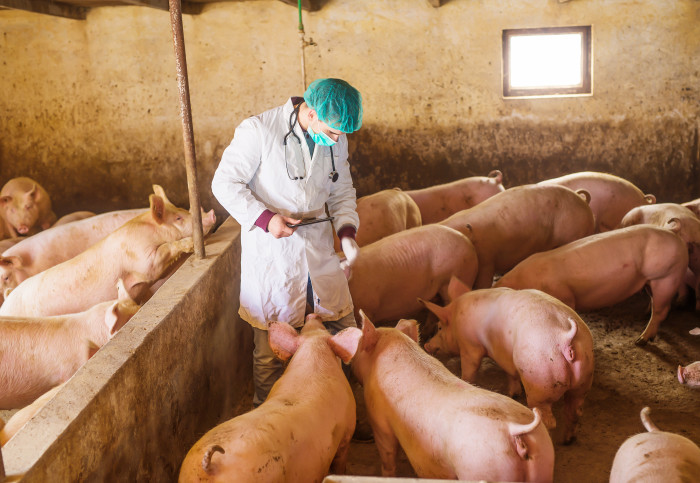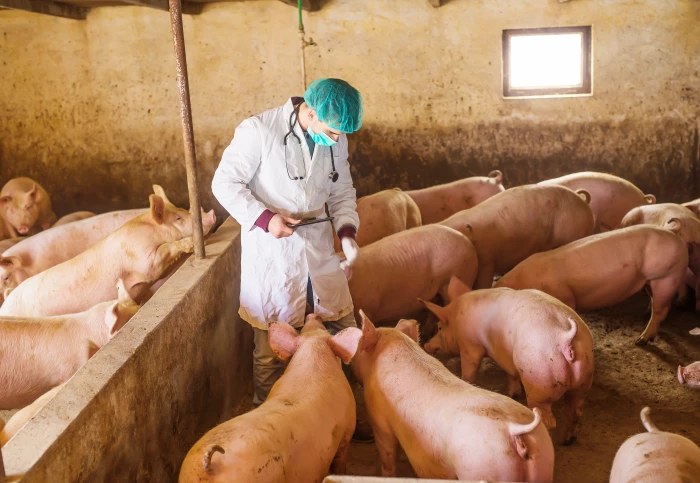Innovative test for pig infections will bring the diagnostic lab to the farm


A test that will diagnose pig lung infections on the spot is being developed by Imperial researchers, together with College startup ProtonDx.
A long-running research effort at Imperial to improve the diagnosis of lung infections in pigs is reaching its conclusion. A government-funded project is underway to validate the method, first using samples sent in from farms across the country, then on the farms themselves.
“This is the culmination of years of work for me and I am confident this is going to work,” says Professor Paul Langford, from the Department of Infectious Disease. “I’m retiring in the next couple of years, and it would be satisfying if a device was on or near to market by then.”

The target of the research is Porcine Respiratory Disease Complex (PRDC), which can be caused by five different bacterial pathogens and three viruses, sometimes acting alone, sometimes acting together. A test that tells vets exactly what kind of infection is present in a herd would be a great help in managing outbreaks or even in carrying out disease surveillance.
The conventional approach to testing involves sending samples of lung tissue from diseased pigs off to a lab for analysis. This can be time-consuming and costly, but more importantly, will only confirm if a single suspected pathogen is present or not. A vet visiting the farm either has to guess and ask the lab for confirmation, or have it run eight separate tests. And getting a result on the spot is impossible.
“There is nothing on the market that can detect one, let alone all eight pathogens on the farm,” says Professor Langford. “And this is the kind of test that we set out to develop.”
Three viruses, five bacteria, one test
The first step was a research project funded by the Biotechnology and Biological Sciences Research Council (BBSRC), which brought together several universities to examine the five PRDC bacteria for genetic markers that would make it possible to tell them apart. Another BBSRC-funded project followed to add markers for the viruses and to start working with the pig farming industry on a prototype test.
The use of point-of-need diagnostics will enable fast remedial action on farms. Robert Enck ProtonDx
The arrival of the COVID-19 pandemic put a brake on this work. Conversely, it gave a boost to Imperial startup ProtonDx, which was able to bring a mobile test for human respiratory diseases to the market while the pandemic was raging. It is this technology that will now be used by Professor Langford and postgraduate researcher Oliver Stringer to translate the earlier PRDC research into a prototype test.
“We are excited to have the opportunity to extend the capability of our automated molecular diagnostic platform,” says Robert Enck, the chairman and president of ProtonDx. “It is hoped that the use of point-of-need diagnostics ‘in the field’ will provide rapid and accurate pathogen detection. This will enable fast remedial action on farms, including support of correct dosing of appropriate antibiotics, as well as vaccine protocols and usage, thereby helping to address the rising issue of antibiotic resistance in the global pig farming industry.”
This work will be supported with a £505,000 grant from the Department for Environment, Food and Rural Affairs’ Innovation Programme and Innovate UK’s Transforming Food Production Challenge. The project will also involve livestock farmers, the UK’s Animal Plant Health Agency, and industry experts.
“The industry is also closely involved in how the device should be designed and what would be useful for them on the farm,” Professor Langford says. “What they want is something that is small and portable, and which can be charged easily, say from a car’s auxiliary power outlet.” The expectation is also that the cost of the tests will be much less than sending samples away to a lab.
From piste to pig pen
ProtonDx’s approach is based on an innovative sample collection and analysis technique conceived in the labs of Dr Jesus Rodriguez Manzano, from the Department of Infectious Disease, and Professor Pantelis Georgiou, from the Department of Electrical and Electronic Engineering. The method provides a very pure and amplifed DNA/RNA sample, without the need for laboratory processing. This means that testing can be done on-the-spot, even in challenging conditions.
If it works in the lab, it will work in the ProtonDx system. That’s the beauty of what the company has developed. Professor Paul Langford Department of Infectious Disease
The company’s Dragonfly 5-in-1 Respiratory Test Panel can detect the low viral loads present during the early stages of a respiratory infection in humans, and distinguish rapidly between virus types, indicating whether it has found influenza A, influenza B, respiratory syncytial virus (RSV), rhinovirus or the SARS-CoV-2 virus responsible for COVID-19. The Dragonfly system is easily portable, providing results in half an hour that are as reliable as a PCR test. Dragonfly recently proved its worth screening Team GB’s competitors at the Winter Olympics in Beijing, and Team Scotland’s athletes at the Commonwealth Games in Birmingham.
“This grant will support the adaption of our proprietary ‘lab-on-a-chip’ technology, which is able to identify bacterial and viral pathogens directly with minimal sample handling,” says Professor Georgiou, who in addition to his role at Imperial is also chief executive of ProtonDx. “Our multidisciplinary team are thrilled to have the opportunity to co-create an automated diagnostic solution that will be able to test the eight major bacterial and viral pathogens seen in PRDC, at once.”
Adapting the existing ProtonDx test to the new genetic markers will be relatively straightforward. “If it works in the lab, it will work in the ProtonDx system. That’s the beauty of what the company has developed,” says Professor Langford.
For the team at ProtonDx, this is just another step in the development process. “We do have to design new bespoke primer sets, which are specific to the targeted porcine viral and bacterial genomes,” says Matthew Cavuto, Head of Engineering and Product Development. “On that point, the team has a vast amount of experience with primer design, and it will not present any significant challenge.”
New sampling solutions
Adaptations will also be required to the sampling method. The Dragonfly device works with nasal swabs, which perform well for respiratory infections in humans, but not for lung diseases in pigs. Swabs from pig lung tissue work, up to a point, but the ideal would be to find a way of sampling genetic material from the lung itself, to get at intra-cellular pathogens, for example.
“The challenge of adapting the current technology to the new setting is primarily centred around tweaking the sample extraction process to work for new sample types, such as tissue and blood,” says Dr Rodriguez Manzano, who is also chief scientific officer at ProtonDx. “But this is just another step in the product development process, which we are currently undertaking with promising results on the horizon.”
Initially the project will involve laboratory testing of samples of pig lungs supplied by farmers around the UK. “We will look at the load of bacteria or virus in those samples, and eventually, when the device is ready, carry out tests on the farm,” says Professor Langford.
The final aim is for sample preparation to be seamlessly integrated into the test using lab-on-chip technology. “Part of this project is to develop a system where you can take a piece of lung material, put it in a cartridge, put the cartridge in the machine, and it will then do everything for you,” says Professor Langford. “It will mash up the tissue, extract the sample, and analyse it.” Another industrial partner is developing this aspect of the device.
Main picture: Getty Images/Dusan Petkovic
Supporters
Article text (excluding photos or graphics) © Imperial College London.
Photos and graphics subject to third party copyright used with permission or © Imperial College London.